Wooden dial 1:1 Rolex super clone watches fall into a category I like to call “weird design things that happened during the 1970s.”
I have a tendency to over-romanticize the disco decade, much to my French grandmother’s chagrin. She told me over the phone the other night: “Ugh, mais non Malaika, the ’70s was the worst period in fashion. So synthetic, so tacky. Not chic. Quelle horreur!”
Well, Granny, this time we must agree to disagree. I’m all about stacks of gold jewelry, glittery spandex fabric, clunky platform shoes, and enormous bell bottom pants. And wood, plenty of wood.
Wooden accessories belong to the bohemian side of the ’70s. More Mick Jagger in Performance, swathed in fabric, covered in earthy adornments, laid out on a shaggy rug – and less John Travolta dancing under a disco ball in a white three piece suit in Saturday Night Fever. They were a signature look for the great arbiter of bohemian fashion: Yves Saint Laurent muse LouLou de La Falaise. As far as I’m aware, LouLou didn’t wear wooden UK best Rolex replica watches – but she did wear huge wooden earrings, beads, and bangles layered with semi-precious stones, enamel, and rock crystal pendants. She proved how stylish dead trees can be. And when I think of how to wear wood-dial watches today, she’s the inspiration.
Wooden-dial watches fall somewhere in between earthy and bohemian in matière but bold and sometimes outlandish in shape. And yes, the good ones are all made with real wood.
The best wood-dial cheap super clone Rolex watches from this time period are retro in every sense of the word, but I suppose it would be cheating if I made this all about the 1970s. There were wacky and also elegant wooden dials created in the 1960s, and some pretty fancy wooden dials that continued being made into the 1980s – and more came after that, too, all the way up to the Patek Philippe marquetry dials that started being made in the 2000s.
But the 1970s stick out as the golden age for experimentation in both form and material, from beautiful stone dials and hammered gold bracelets by Audemars Piguet to triangular shaped “Trinidad” cases and biomorphic Grima designs at Omega. An ideal era for the watch world’s Wood Period.
Although these wacky watches originated in a particular time period and are now a symbol of mid-century to late-’70s design, these products weren’t nostalgic when first produced. They were meant to be futuristic in the same way that MB&F and Urwerk are today.
I’ll be the first to admit that wooden dials don’t exude glamor in the same way that tiger’s eye, lapis, or onyx dials do. Maybe that’s why wood never caught on the way stone did. The totally offbeat 20th-century wooden dial Swiss made Rolex fake watches listed below – minus burl wood Day-Dates and Datejusts – also lie in stark contrast to the classicism that many brands yearn to achieve today. Classic design cuts through the timeline and transcends the era in which it was created, and if a product is timeless I suppose the logic is that it will sell for longer. But some of us prefer period-perfect idiosyncrasy.
I’m certain that these wood high quality super clone Rolex watches will forever remain in the niche collector category, but they’re still fun to look at and evocative of a freewheeling time when creativity ruled.
Rolex
The eternally beloved Rolex Day-Date was introduced in 1956 as the brand’s “flagship” model, and it went on to be the foundation for a whole host of (now) extremely covetable dial variations. The early ’70s saw the introduction of high gloss enamel Stella dials, as well as the use of semi-precious hardstone dials such as lapis and onyx. But an even more unusual variant came in wooden form.
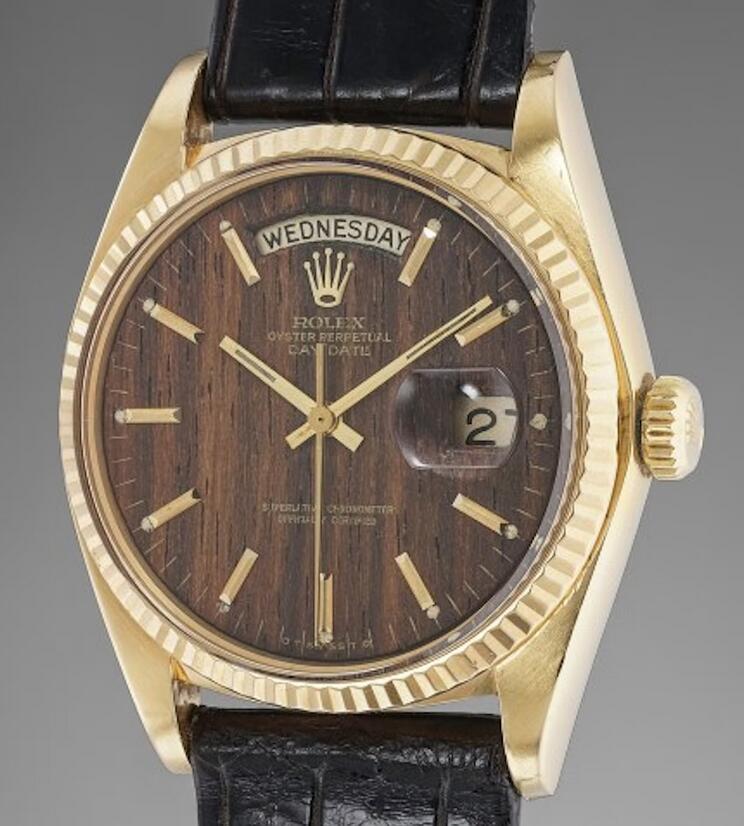
The earlier wood dial Day-Dates in the four digit references (180x with plastic plexi crystal) are often referred to as Sequoia wood dials. The grain pattern was straight and the finish was matte with poor text quality. The fourth figure of the reference number identifies the pattern of the bezel: ref. 1802 features the smooth bezel, ref. 1803 fluted and ref. 1807 bark. These top Rolex copy watches were all produced circa 1973 and housed Caliber 1556.
The bark finish on the bezel and bracelet center link of ref.1807 is a type of finishing first used by Rolex in the early 1970s. This decorative finishing, which mimics the bark of a tree but is not actually made of wood, is particularly effective when paired with a wooden dial.
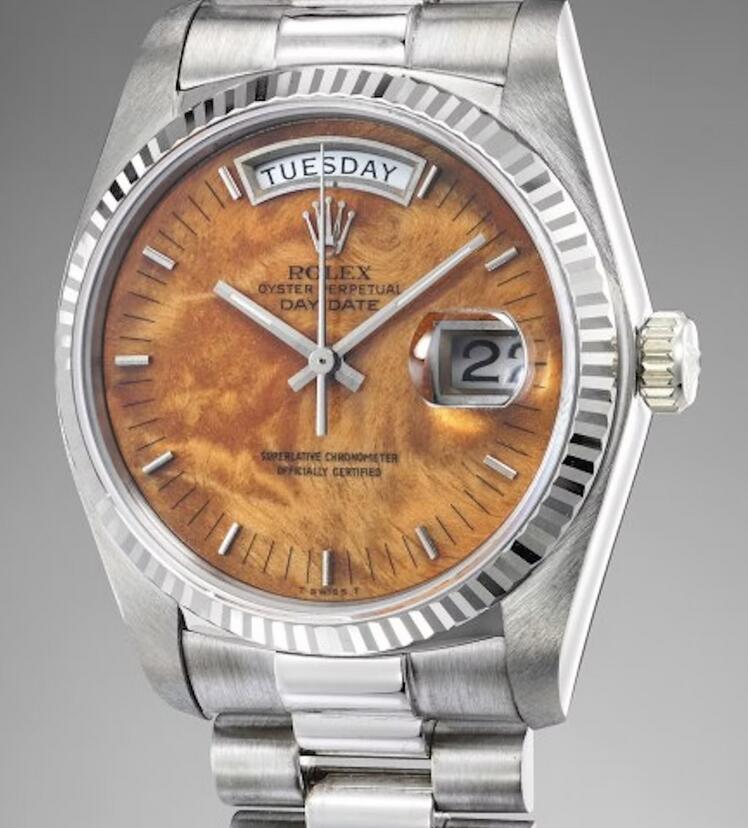
The wooden dials produced later in the ’70s for five serial number Day-Dates (with sapphire crystal) were made using three different types of wood: birchwood, mahogany, and walnut. They had a layer of lacquer applied on them with the print placed on, which in turn made the text significantly more legible. This series housed Caliber 3055 which featured a quickset function.
This generation of wood dial Swiss movements super clone Rolex Day-Date watches is often referred to as burl wood, which is theoretically correct in that burl is a specific grain characteristic that is present on the later generation of wooden dials. But burl is not to be mistaken as a type of tree (like birch or walnut). Burl is actually a growth that forms on the outside of a tree and in turn affects the grain pattern, producing unique knots in the wood.
The more commonly known burl dials most likely replaced the earlier unlacquered sequoia close-grained variants due to burl’s material density and resistance to splitting. I personally find the burly grain more attractive as it looks richer and more unusual. Burl wood furniture was popular in the Art Deco period and had a resurgence in, you guessed it, the 1970s. I fell down a burl-themed Milo Baughman rabbit hole during my research – I’m now in the market for a burl wood credenza. Oops!
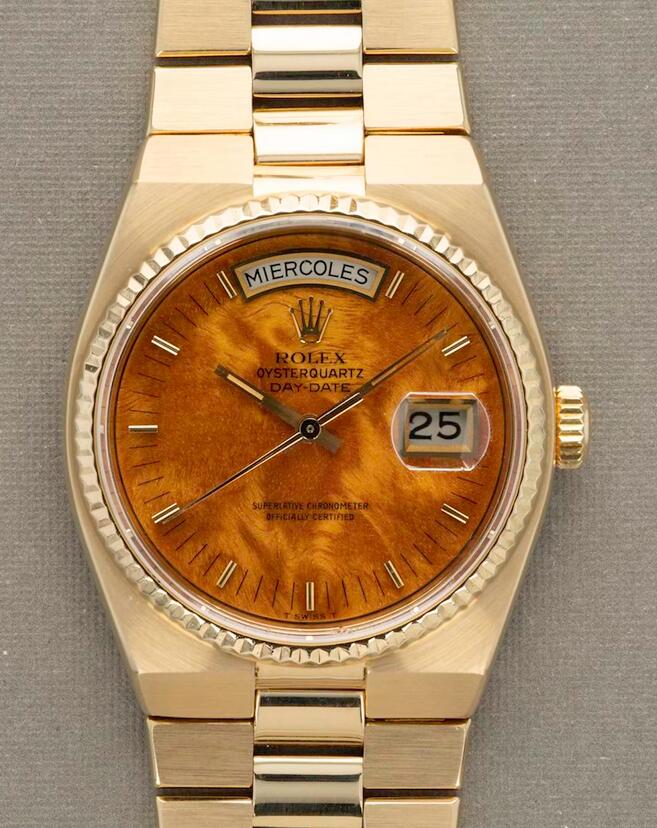
Below are some fun variants on the wood dial best quality Rolex Day-Date replica watches. The Oysterquartz ref. 19018 also came in a solid wood dial version as well as a diamond pattern variant referred to as “Wooden Roulette.” and Oysterquartz Day-Date ref.19028 with a “Clous de Paris” / pyramid pattern on the bracelet and bezel.
You can find Datejust models produced with wooden dials, too, including refs. 16018 and 16019 first produced circa 1979. And Lady Datejust models 6917 and 69278 were also around starting in the late ’70s.
Rolex Cellinis
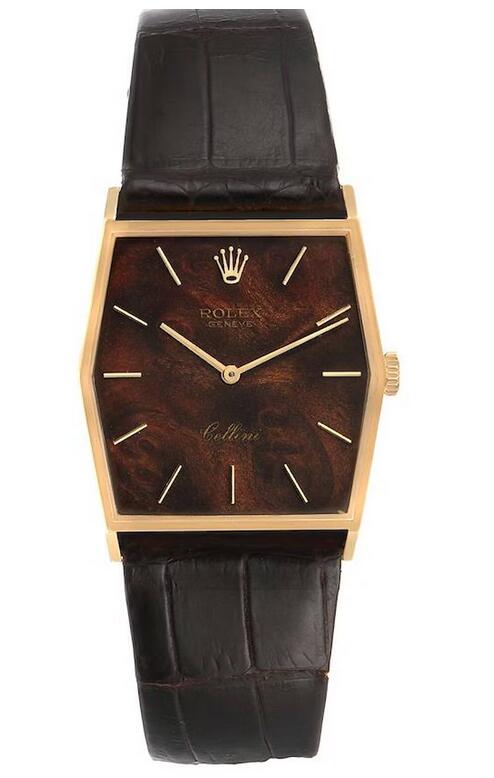
Rolex also made a fair amount of wood dials for its China super clone Rolex Cellini line watches. The hexagonal tonneau-shaped ref. 4122 with mahogany dial measures around 28mm x 30 to 35mm, depending on the model, and looks like something a cigar-smoking, backgammon-playing aristocrat would wear to the Groucho Club in London.
The AAA fake Rolex Midas Cellini watches, which seems to be having a bit of a comeback these days, was also produced with a wooden dial variant. Ref. 4126 (pictured below) features a burled walnut dial inside an 18k yellow gold case with hobnail-textured finishing in the bezel.
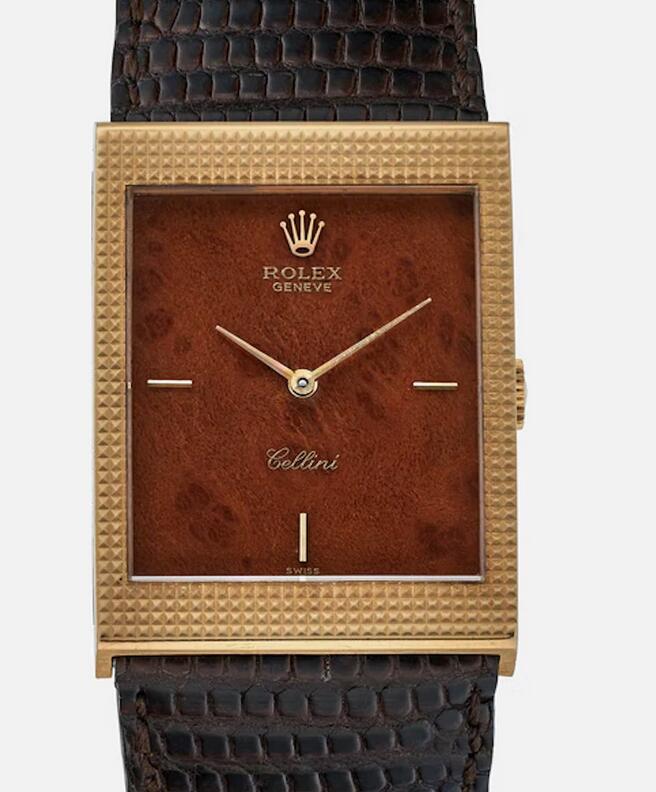
There’s also the ref. 4127 with a mahogany burl dial and pyramid motif bezel. This rectangular-shaped case Cellinii measures 33 x 24 mm and was produced circa 1976.
The Genta designed octagonal wholesale super clone Rolex Cellini ref. 4350 watches with mahogany dial is a sleeper hit as well as the diamond-set ref. 4651. Both of these variants are lust-worthy for their deliciously chunky yellow gold case and bracelet. These are just about as ’70s as it gets for uniquely shaped dress watches.